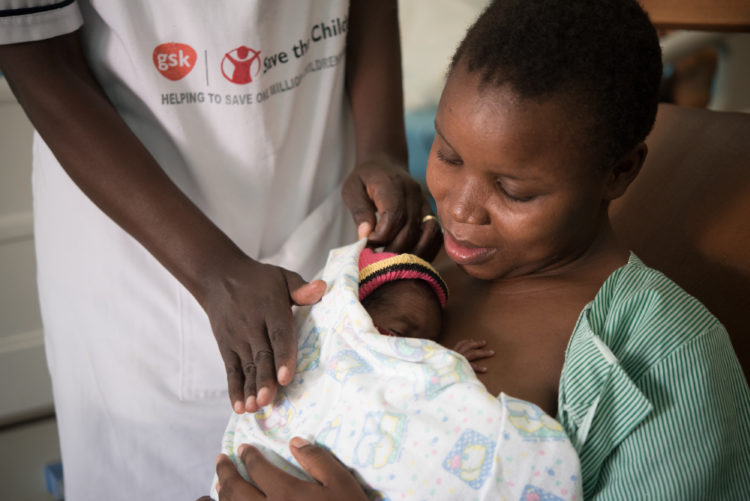This post is part of a series authored by the BASICS (Bold Action to Stop Infections in Clinical Settings) team. BASICS is a new initiative that will transform healthcare and reduce healthcare-associated infections (HAIs) by at least 50%. Written by the BASICS team.
The unintended dangerous effects of pandemics on maternal and newborn health are not new.
During the Ebola crisis of 2015-16, more women and girls died of obstetric complications than the infectious disease itself.
For COVID-19, the situation is no different. While some emerging evidence suggests that COVID-19-infected pregnant women may be at higher risk of pre-term birth[1] and that pregnant women with pre-existing conditions may face complications, it appears that healthy pregnant women face few direct adverse effects of the virus. There is also no evidence of vertical mother-to-newborn transmission during pregnancy or via breastfeeding, and the few infants with confirmed COVID-19 have experienced mild illness.[2] Current guidance on caring for babies of mothers with COVID-19 are available here.
However, Save the Children’s own experiences responding to disease outbreaks in low- and middle-income countries, modeling data and other evidence point to a number of worrying indirect effects the pandemic may have on mothers and newborns. The myriad complications of the COVID-19 pandemic – from overwhelmed health systems to government lockdowns that may restrict a woman’s access to health care, and to families simply being unable to afford transportation to a distant health post because of lost incomes – are conspiring to disrupt maternal and newborn care and jeopardizing hard-won progress in reducing maternal and newborn mortality.
- Facility care may be disrupted or diminished as health staff and materials, including those necessary for infection prevention and control (IPC), are re-deployed or prioritized for departments likely to see COVID-19 patients.
- Fear of physical proximity may limit or alter care provision. Social distancing and the fear of spreading the virus may lead health workers to deny laboring mothers an outside birth companion or to separate newborns from mothers after delivery. We are aware of such instances occurring through the country programs we support and the working groups and forums we participate in. Essential care for every newborn should include immediate skin-to-skin contact and early initiation of breastfeeding. This is especially critical for pre-term and small babies whose survival relies on the practice of Kangaroo Mother Care, which includes – among other practices – early, continuous and prolonged skin-to-skin contact between the mother and the newborn.
- Government-ordered curfews and lockdowns may prevent or inhibit women’s access to routine antenatal care or emergency care, or to cause them to give birth at home without the support of a trained midwife or health worker.
- Families’ economic shocks from lost jobs and livelihoods may make the cost of transportation to a health facility or facility fees prohibitive.
- Mixed messages about how the virus can be transmitted and fear of physical closeness may reduce breastfeeding rates.
Over the past two decades, individuals, families, communities and countries have achieved significant improvements in health outcomes for mothers and newborns. Maternal death rates globally fell 38.3 percent, from 342 deaths per 100,000 live births in 2000 to 211 per 100,000 live births in 2017[3]. Newborn death rates declined by 43 percent, from 31.5 deaths per 1,000 live births in 2000 to 17.7 per 1,000 live births in 2017[4]. The increased access to safe healthcare has been one of the main reasons for these improvements. For example, the percentage of births globally that were attended by skilled personnel increased from 64% in 2000 to 81% in 2019.[5]
The impacts of COVID-19 can easily erode some of these hard-won gains in reduced mortality over the past two decades.
So what can we do? It is essential to ensure mothers feel safe going to a health facility and health providers are empowered with knowledge and tools. WHO, Save the Children and other partners recommend that health facilities:
- Maintain and promote essential, evidence-based maternal and newborn health services such as antenatal care for pregnant women, skilled attendance during labor and delivery and essential newborn care;
- Practice IPC in all departments and wards, but especially in the spaces where pregnant women, laboring mothers and newborns receive care. This includes routinely cleaning and disinfecting surfaces to help prevent the spread of disease, and practicing strict hand hygiene (handwashing) before and after contact with the mother and newborn;
- Encourage mother-baby contact instead of isolation. Mothers and newborns should not be separated. Mothers should be encouraged to breastfeed and practice immediate skin-to-skin contact for low weight/preterm babies while following the appropriate protective measures. For asymptomatic and non COVID 19 exposed mothers, this means practicing respiratory hygiene, avoiding touching the mouth and face, practicing hand washing with soap and running water or using sanitizer where possible, following distancing recommendations and reporting symptoms.
- Engage mothers and communities to understand their needs, questions and fears, which will help to tailor approaches and health messages to communicate effectively, both about the risks of COVID-19 and the benefits of essential maternal and newborn health services.
These are basic yet powerful actions that will ensure pregnant women, mothers and their newborns continue receive quality care during the pandemic and that those caring for them will help keep them healthy and thriving. Maternity and newborn wards, in which all staff are trained in and practicing strict hygiene and IPC protocols as second nature, become safer environments and places where the risk of acquiring an infectious disease is greatly reduced.
The BASICS model ensures IPC measures are embedded in the delivery of health care to pregnant women, mothers and newborns –in the midst of COVID-19 as well as for the future so that if the next pandemic hits, health systems will be prepared.
[1] https://www.sciencedirect.com/science/article/pii/S2589933320300379?via%3Dihub
[2] https://www.healthynewbornnetwork.org/resource/covid19-interim-guidance-who/
[3] https://www.who.int/reproductivehealth/publications/maternal-mortality-2000-2017/en/
[4] https://data.unicef.org/topic/child-survival/neonatal-mortality/
[5] https://data.unicef.org/topic/maternal-health/delivery-care/
